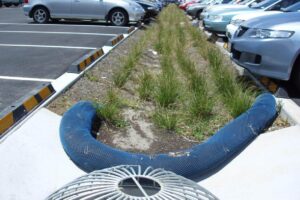The use of green infrastructure to deal with stormwater in New Zealand fairly new. Most of New Zealand’s stormwater has been handled in a conventional manner: put it into a pipe and send it to the harbor. However, there has been a new trend to deal with stormwater on site. I had the opportunity to explore a few of the locations where this is happening with Robyn Simcock, who works with Land Care Research through the University of Auckland.
Stormwater issues in the Auckland area vary from those in the U.S. in terms of the pollutants that are of concern. In Auckland, they are most concerned about copper, zinc, water quantity, and sediment. The source of the zinc is from the metal roofs and road pollutants. The source of the copper still is not completely determined at this time.
The first place we visited was Stonefields, a master planned community situated in an old quarry. The site has been developed as mixed use, with a town center surrounded by a variety of residential areas. Unique to the site is the concept of handling stormwater with better management practices and more dense development than in most parts of Auckland.
 The stormwater on the site is managed through what is called a “third pipe” water system, which collects and reuses stormwater within the community (to water gardens and flush toilets). All runoff from Stonefields’ street system is collected in a system of bioswales (called raingardens here) and drains to a wetland, which is used as a park area.
The stormwater on the site is managed through what is called a “third pipe” water system, which collects and reuses stormwater within the community (to water gardens and flush toilets). All runoff from Stonefields’ street system is collected in a system of bioswales (called raingardens here) and drains to a wetland, which is used as a park area.
We also visited the Albany Town Centre. Located north of Auckland, Albany was to be a new town center for the outer suburbs until the economy collapsed. Since then, development has slowed considerably. Within the transportation park and ride, a treatment train for the stormwater runoff was constructed. Land Care Research previously used the upper portion of this site as a research facility. First the water flows into a series of swales that then drain to a wetland, before entering a stream. The wetland is adjacent to the stream and is planted with a monoculture of a native species.
We looked at how the design of the bioswales on the site has progressed from four years ago to today. The older ones were over designed, with very large inlets containing concreted rock aprons. However, the vegetation has required little maintenance. The next stage has luxuriant vegetative growth, at times a bit excessive, not allowing water to get into the inlets. The outlets are still a meter across.

Suzanne stands beside the luxuriant growth
The final stage of bioswale design has slightly smaller outlets, but the vegetation is more manageable and requires less maintenance. There is also a greater variety of species present. These last bioswales are part of a treatment train that includes pervious pavers or bioswale that drain to tree pits. The water then goes through a grass swale down to two ponds before entering Lucas Creek.
After visiting these two sites and Wynyard Quarter – which will be discussed in a subsequent post, the conclusion that can be drawn about green infrastructure stormwater practices here in Auckland is that it is a relatively new practice that still needs some fine tuning.
Further Reading
Meet Assistant Construction Project Team Leader Bryan SullivanMeet Conservation Biologist Nolan Schillerstrom
Get to know Allyson Gibson, Biohabitats Extern
Get to Know Graphic Designer Joey Marshall
Evolution: A New Leadership Team for Biohabitats
More From This Author
“Alone in a world of wounds”An American Ecologist in New Zealand: Part II
An American Ecologist in New Zealand Part V: What is a Cittaslow?
An American Ecologist in New Zealand: Part IV, Green Roofs!
Aloha: An unforgettable trip to the bathroom

